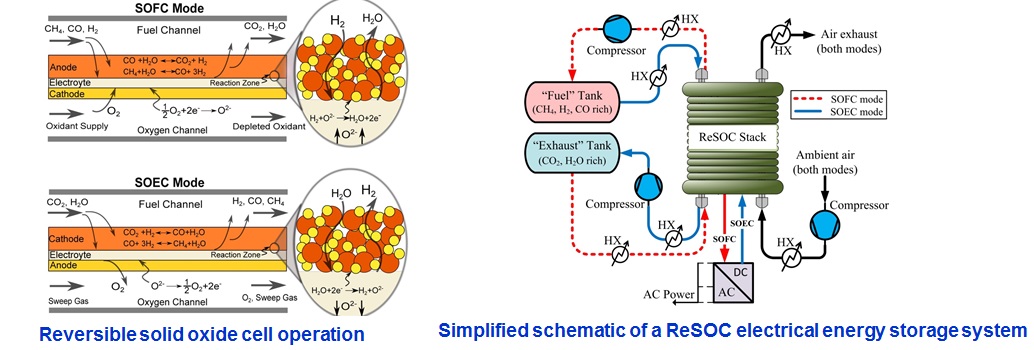Design and Analysis of Reversible Solid Oxide Cells For Electrical Energy Storage
Electrical energy storage is expected to be a critical component of future energy systems, performing load-leveling operations to enable increased penetration of renewable and distributed generation. The U.S. Department of Energy recently published long-term targets for grid energy storage of 80% roundtrip efficiency, 150 $/kWh capital cost and 10 ¢/kWh-cycle levelized cost to fulfill energy management applications like energy time-shifting, transmission and distribution upgrade deferral, and customer energy management services. Reversible solid oxide cell (ReSOC) flow battery systems are a novel technology that may be able to meet all of the DOE criteria described above. A ReSOC is an operationally flexible energy conversion device which can operate in both power producing (solid oxide fuel cell, SOFC) and fuel producing (solid oxide electrolysis cell, SOEC) modes. A stand-alone energy storage system is realized from this technology by coupling the two modes of operation with intermediate storage of gaseous “fuel” and “exhaust” species. However, challenges ranging from cell performance and durability to system integration and thermal management must be addressed before the technology sees widespread adoption.
The AES group has for several years collaborated with Scott Barnett at Northwestern University to address these challenges. The two groups have worked together to leverage an operating strategy that uses carbonaceous reactant species and operation at intermediate stack temperature (600-650°C) to promote exothermic fuel-synthesis reactions that thermally self-sustain the electrolysis process. Where Barnett’s team has focused on improving cell performance and manufacturing techniques, the AES group’s primary effort has been developing system level concepts for deploying ReSOCs as efficient and cost effective energy storage devices. This includes investigation of stack thermal management and system integration, dynamic system operation, and techno-economic analysis of these systems.
FUNDING: Stanford Global Climate and Energy Project

Publications
- C. Wendel, P. Kazempoor, and R.J. Braun, “A thermodynamic approach for selecting operating conditions in the design of reversible solid oxide cell energy systems,”, Journal of Power Sources 301 (2016): 93-104.
- S.H. Jensen, C. Graves, M. Mogensen, C. Wendel, R.J. Braun, G. Hughes, Z. Gao, and S.A. Barnett, “Large-scale electrical energy storage utilizing reversible solid oxide cells combined with underground storage of CO2 and CH4,” Energy and Environmental Science 8 (2015), 2471-2479
- C. Wendel, P. Kazempoor, and R.J. Braun, “Novel electrical energy storage system based on reversible solid oxide cells: System design and operating conditions,” Journal of Power Sources 276 (2015): 133-144.
- C. Wendel and R.J. Braun, “Modeling and experimental performance of an intermediate temperature reversible solid oxide cell for high efficiency, distributed-scale electrical energy storage,” Journal of Power Sources 283 (2015) 329-342.
- P. Kazempoor and R.J. Braun, “Model validation and performance analysis of regenerative solid oxide cells: Electrolytic operation,” International Journal of Hydrogen Energy Volume 39, Issue 36 (2014) 2669-2684.
- P. Kazempoor and R.J. Braun, “Model validation and performance analysis of regenerative solid oxide cells: Reversible operation,” International Journal of Hydrogen Energy Volume 39, Issue 11 (2014) 5955-5971.